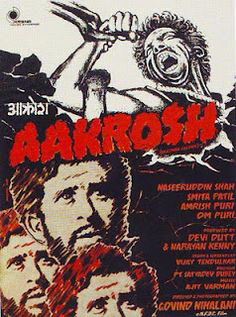Aakrosh Anger—The Man’s Right !
This article was first published in the print edition of Manushi Journal. (Issue-8, 1981)
This film is a step ahead of the average Hindi film in that it does not glamorize poverty into a saleable commodity or present the usual cosmetic version of injustice. It is a bold statement against the structures of corrupt power which control the lives of most of us, whether we realize it or not.
The hero of the film is a young lawyer (Naseerudin) employed by the state. He attempts to defend a tribal man who is accused of having murdered his wife. The film takes its title from the anger of this tribal named Lahaniya who refuses to speak a word in his own defence or to present his version of the story. Unable to get a single word out of Lahaniya, the lawyer tries other means of gathering evidence. He goes to the tribal village where Lahaniya’s father, sister and other villagers maintain the same hostile silence. In the course of
his quest, Naseerudin gradually uncovers layer upon layer of intrigue. He finds that all the respectable gentry of this small Maharashtra town are actually inhuman brutes who perpetrate and uphold a reign of terror over the landless tribals. This process of politicization of a non-exceptional middle-class youth is well depicted. Without much jargon or speech- making, he is brought face to face with the reality of oppressors versus oppressed and is forced to take sides against his own social circle —all the influential, rich men (doctor, contractor, MLA) who, he finds, are the rapists and murderers of Lahaniya’s wife…






